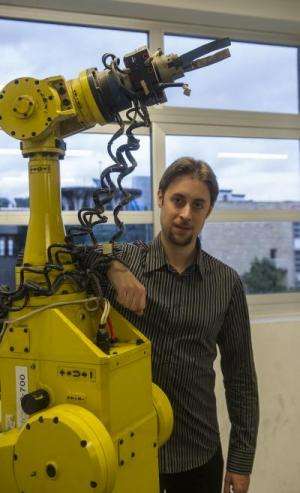New program simulates protein movements

Proteins are molecules involved in most of the biological processes that take place in our bodies. They have to move in order to fulfil many of their functions. For example, they open or close to keep and transport the molecules inside them. Until now, costly methods were the only available option for studying these movements: supercomputers were needed and the calculations took many days. The department of mechanics of the Faculty of Engineering in Bilbao has now developed a shorter method. On the basis of the similarity in the way robots and proteins move, the theorems and algorithms used for studying and simulating the mechanisms have been adapted. That way, it is possible to find out more quickly and with the necessary precision how protein movement functions and facilitate the means for influencing the processes in which these molecules participate. The CIC bioGUNE centre is collaborating in this project, thus proving that bioscientific research and mechanical engineering are not that far removed from each other.
Protein study is one of the most interesting areas in today's sciences. More and more disciplines are coming together in this field. It is where physicists, biologists, mathematicians and now engineers are running some of their research. The interdisciplinary co-operation between the department of mechanics of the Faculty of Engineering in Bilbao and the CIC bioGUNE centre that does research in the area of biosciences is now yielding a wealth of results: the engineers have developed software designed to study protein movement and which is faster and cheaper than the programmes used previously.
Some proteins are static. They are the bricks the body uses to build skin or muscles. Others, however, work on the move, they are dynamic ones. For example, they have to combine with a chemical component to carry out their function. Until now, experimental methods have been used to study static structures; they include X-ray crystallography and nuclear magnetic resonance. However, these methods are of no use for proteins that are on the move; analytical methods, computer simulations, have to be used. Supercomputers are needed and it takes days or even months to make all the calculations.
The difficulty lies in the nature of the movement of the proteins themselves. Explained simply, the structures of proteins have the capacity to move in a way that is similar to the way an arm moves. But whereas an arm has three joints, proteins may have hundreds and thousands of them and that makes the simulation more complex. The COMPMECH research group of the department of mechanics of the Faculty of Engineering in Bilbao has developed a programme to simplify that. They have seen that there is a great similarity between protein and robot movements, in particular those of the robots used on car assembly lines. The COMPMECH research group has in fact wide experience in the study of this kind of mechanisms and they have applied the theorems and algorithms used in studying the simulation and engineering of mechanisms to proteins. The aim was to simulate protein movement involving a lower computational cost, while always maintaining the biological nature of the protein. They have worked on four proteins and in two different situations. Firstly, how proteins move when fulfilling their function, and secondly, a simulation to see how they achieve a three-dimensional structure; proteins are long chains at first and then they fold.
Interdisciplinarity
To run the project, the engineers have been accompanied by Luis-Alfonso Martinez Cruz, the head of the CIC bioGUNE x-ray crystallography laboratory, to confirm all the hypotheses produced in the research. Simplifying the method for finding out about protein movement will facilitate the work of researchers involved in studying proteins. So once they have studied by means of simulation how proteins moves when interacting with a specific molecule, it will be possible to know, for example, which is the proper geometry for other compound to fit inside and interact with the protein. So, it would be possible to find compounds that block the movement and prevent the protein from carrying out its function, which is what drugs do. As pointed out already, these biomolecules participate in most of the biological processes that take place in our bodies and in some diseases as well, like cancer or Alzheimer's, so the control of protein movement could open up many doors. At CIC bioGUNE they are working along these lines. When protein movement is better understood, it may be possible to know which compounds they can bond with or what function they could perform in a different situation, and this new simulation tool will simplify the task.
More information: Mikel Diez, Víctor Petuya, Luis Alfonso Martínez-Cruz, Alfonso Hernández, A biokinematic approach for the computational simulation of proteins molecular mechanism Original Research Article. Mechanism and Machine Theory, Volume 46, Issue 12, December 2011, Pages 1854-1868.
Mikel Diez, Víctor Petuya, Luis Alfonso Martínez-Cruz, Alfonso Hernández, Biokinematic protein simulation by an adaptive dihedral angle approach Original Research Article. Mechanism and Machine Theory, Volume 69, November 2013, Pages 105-114.
Provided by Elhuyar Fundazioa
















